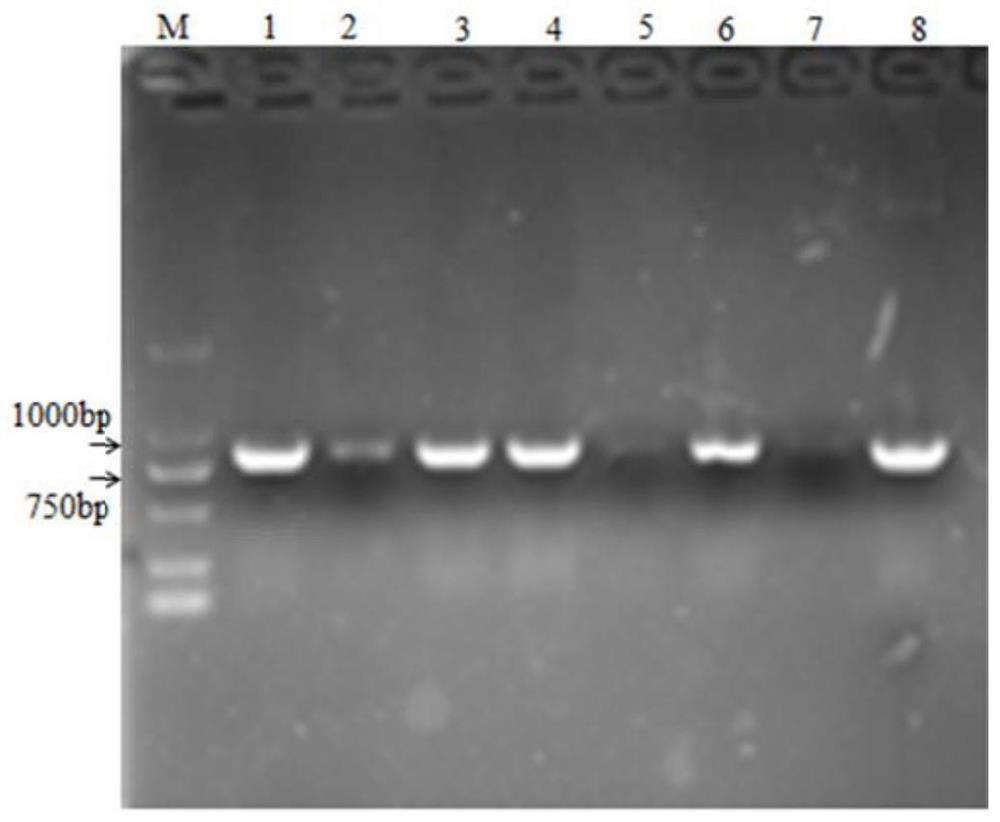Application of clematis terniflora isopentenyl transferase PT1 gene, overexpressed arabidopsis thaliana strain thereof and construction method of overexpressed arabidopsis thaliana strain
A technology of lotus isoprene and a construction method, applied in the field of plant genetic engineering, can solve problems such as insufficient UV stress resistance, and achieve the effect of strong resistance
- Summary
- Abstract
- Description
- Claims
- Application Information
AI Technical Summary
Problems solved by technology
Method used
Image
Examples
Embodiment 1
[0066] The present embodiment has carried out the cloning and expression of Clematis chinensis isopentenyl transferase PT1 gene, and the specific method is as follows:
[0067] Trizol method was used to extract the clematis cone RNA, reverse transcription to obtain cDNA, and high-fidelity enzyme was used to amplify the PT1 gene sequence (SEQ ID NO. 1) from the cDNA template.
[0068] Forward primer: 5'-ATGATTTCTGCTTTAGCTTCTCCA-3'
[0069] Reverse primer: 5'-TCAACAAACAAAGGGAATAAGCAAA-3'
[0070] The PCR amplification system is: template 1 μL, 2× PCR buffer 10 μL, upstream and downstream primers 0.8 μL each, dNTP 0.4 μL, Polymerase 0.4 μL, supplemented with ddH 2 0 to 50 μL. Denaturation at 95°C for 3 min; 35 cycles of 15 S at 95°C, 30 S at 52°C, 1 min at 72°C; extension at 72°C for 5 min, and storage at 4°C. PCR products were stored at -20°C after electrophoresis, recovery and sequencing.
[0071] Use SteadyPure DNA Gel Recovery Kit (AG Company) to perform gel recovery of t...
Embodiment 2
[0082] In this example, the overexpressed Arabidopsis thaliana lines obtained in Example 1 were used for screening, and four transgenic Arabidopsis thaliana plants were obtained. Studies on changing plant phenotypes are as follows:
[0083]Six overexpressed Arabidopsis thaliana strains and 12 original wild-type Arabidopsis thaliana strains were sown respectively. The specific operation and culture conditions were as follows: Arabidopsis thaliana seeds were sown on the surface of the seedling block, and placed in the light at a temperature of 21±2°C. Grow in an incubator with a light cycle of 16h light / 8h dark, and a light intensity of 8000Lx. After about 15 days, the seedlings were transplanted, and the Arabidopsis thaliana was transferred from the seedling block to a 6cm × 6cm square flowerpot, and the culture conditions remained unchanged.
[0084] Primer validation experiments were performed on each transgenic Arabidopsis, such as figure 1 The gel electrophoresis results s...
Embodiment 3
[0087] This embodiment utilizes the transgenic Arabidopsis thaliana obtained in Example 2 and the original wild-type Arabidopsis thaliana plant to carry out the functional verification of the transgenic plant in improving the plant's resistance to ultraviolet stress, as follows:
[0088] (1) UV irradiation treatment
[0089] The transgenic Arabidopsis thaliana plants and wild-type Arabidopsis thaliana plants were given UV irradiation under the same conditions. The irradiation conditions are as follows: the irradiation time is 72h, and the irradiation intensity is about 14000Lx.
[0090] (2) Phenotypic analysis after UV treatment
[0091] It can be seen that the growth state of transgenic Arabidopsis was significantly better than that of the control after UV treatment for 72 h. The leaves of wild-type Arabidopsis thaliana were severely dehydrated and appeared dry, withered and wilted, while the leaves of transgenic Arabidopsis grew well, only a few of the leaves were wilted, ...
PUM
 Login to View More
Login to View More Abstract
Description
Claims
Application Information
 Login to View More
Login to View More - R&D
- Intellectual Property
- Life Sciences
- Materials
- Tech Scout
- Unparalleled Data Quality
- Higher Quality Content
- 60% Fewer Hallucinations
Browse by: Latest US Patents, China's latest patents, Technical Efficacy Thesaurus, Application Domain, Technology Topic, Popular Technical Reports.
© 2025 PatSnap. All rights reserved.Legal|Privacy policy|Modern Slavery Act Transparency Statement|Sitemap|About US| Contact US: help@patsnap.com



